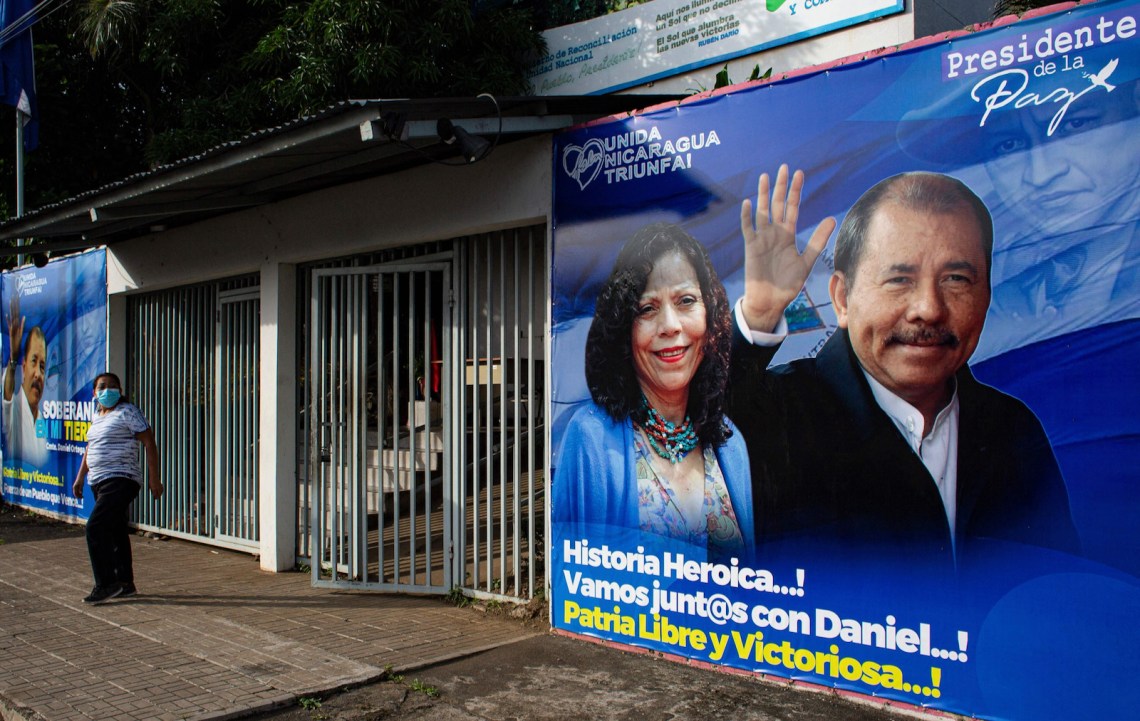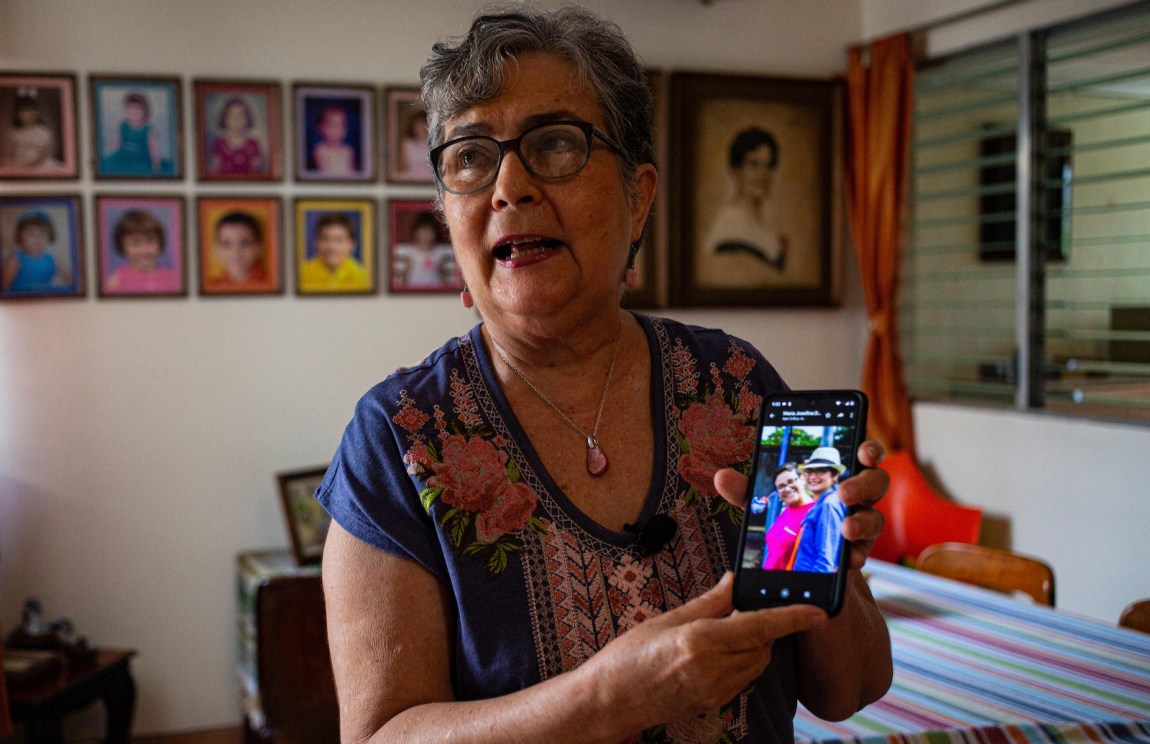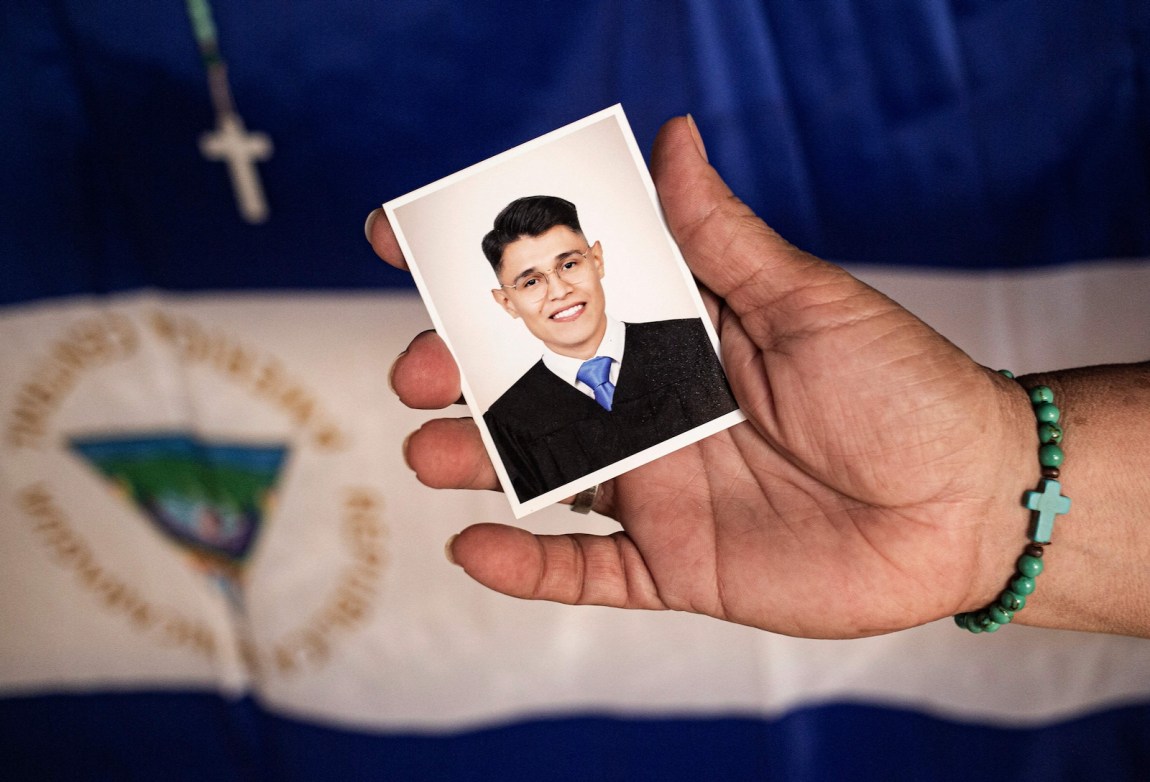An event the official media persist in calling an election will take place in Nicaragua on November 7, when third-time candidate for reelection Daniel Ortega is certain to claim victory. A law Ortega had tailored to his specific needs years ago requires only 35 percent of the vote in order to win, but just to be safe, he has seen all seven potential rivals forcibly removed from the ballot: since May, the government headed by Ortega and his wife, Rosario Murillo, has presided over these candidates’ kidnappings, as they should properly be called according to the the founder and president of the thirty-two-year-old Nicaraguan Center for Human Rights, Vilma Núñez. Her main office has been closed down and destroyed by the government, and she herself lives under constant threat. Thirty more of the regime’s growing number of opponents have been jailed since May. That cohort joins the more than 120 prisoners who participated in huge protests against the Ortegas in 2018. On October 21, the two leading executives of the most important business association were taken away, presumably to prison. “There is great fear that this marks the beginning of a new wave of arrests,” Núñez said over the phone.
The Ortegas know exactly what their fate would be if they allowed a real election. According to the latest opinion poll by CID-Gallup, 69 percent of respondents disapproved of the ruling couple’s performance. Even if they ignore the polling, the state’s intelligence-gathering operations are nonpareil, and the Ortegas can have no illusions about how unpopular they truly are. Murillo, the fearsome and mystically inclined vice president, controls both the neighborhood spying associations that send block-by-block weekly reports on dissent to her office, and the Sandinista Youth associations that monitor student unrest. Hence the need to secure would-be candidates under lock and key before they even had a chance to register. (This strategy has enabled regime officials to argue that what will take place on November 7 is not really an election “because there are no registered candidates.”)
Nicaragua is rife with speculation that Ortega himself, nearing seventy-six years of age, is suffering from some form of dementia and is increasingly unfit to rule: during his now rare public appearances—in September he cancelled his address to the United Nations General Assembly at the last minute—he often appears doddering, distracted, and forgetful. Perhaps he has forgotten what happened on the night of December 27, 1974.
Near midnight that evening, thirteen members of the Sandinista National Liberation Front (FSLN), a then tiny rebel group that had taken up arms against the country’s right-wing dictator Anastasio Somoza, burst into a party held in honor of the US ambassador to Nicaragua. The ambassador had left minutes before but many of Somoza’s dignitaries were still there. That company—including the host, José María Castillo, a former minister of many departments; an uncle of Somoza’s who was the country’s longtime ambassador to Washington; another ambassador or two, an additional minister, and their wives—became the rebels’ captives. It was an extraordinary coup for the guerrilla group, considering that only some of their commandos were seasoned fighters; others were youths with little or no combat experience. Several of the Sandinista unit would not survive the insurgency to see Somoza’s eventual overthrow in July 1979, but among those who did was the operation’s second-in-command, Hugo Torres, a twenty-six-year-old former law student with a sly, mischievous air and a taste for taking life-threatening risks.
Confronted with a hostage crisis involving his own family members, Somoza had agreed to negotiate by dawn. The following day, he promised a million dollars in ransom, the reading over national radio of an FSLN communiqué, and, most importantly, the release of fourteen Sandinista prisoners. Among those who would forever owe their freedom to Torres and his comrades was a somber twenty-nine-year-old militant named Daniel Ortega, who by then had spent most of his young adulthood languishing in Somoza’s dreadful jails.
Times change: Ortega is the soon-to-be reinaugurated president of Nicaragua, and the man who helped free him, Hugo Torres, now seventy-three, is his prisoner.
The would-be candidates’ arrests, devious and legally absurd as they may be, at least have a purpose. But Torres is not one of them, so what to make of his arrest and that of the other twenty-five detainees? Take, for example, the case of Dora María Téllez, whom I remember last as a giggling young woman of twenty-three, dizzy with happiness, days after the Sandinistas deposed Somoza, sitting on her mother’s lap to make room for me in an already crowded car on a day when I desperately needed a ride. She was a true hero of the Sandinista epic, described by the writer Gabriel García Márquez as a “a very lovely, shy and pensive girl of twenty-two; her intelligence and good sense would have assured her of great success in any field.” Together with Torres, she had participated in the Sandinistas’ taking of the National Palace, popularly known as “The Pigsty,” in August of 1978, and was the chief negotiator in that event, calmly obtaining the release of all Sandinista prisoners, their safe passage to Cuba, and another million-dollar ransom. A skilled fighter, she then led the rout of Somoza’s National Guard from the city of León in June of 1979, and established a provisional government until the rest of the country fell to the Sandinistas a month later.
Advertisement
Téllez was the minister of health before she retired from the FSLN in the Nineties to write history and found the Sandinista Renovation Movement party—now called Unamos—with a clutch of other militants, including Torres and Sergio Ramírez, an author and former vice president, who were revolted by what their party, and the Ortega government, had become. Now sixty-five, she was arrested on June 13 of this year, along with her companion, Ana Margarita Vijil, in an operation that involved military troops and circling drones. Also arrested that day were Torres, along with Suyen Barahona, the current president of Unamos. The day before, police had taken in Tamara Dávila, Vijil’s niece and another opposition leader. The four women are the only detainees who have been subjected to solitary confinement.
I talked recently over the phone with Josefina Gurdián, mother of Vijil and grandmother of Dávila. Doña Pinita, as she is known in Managua, where she is famous for her bakery and her cooking programs, was in high spirits that day. For just the second time in four months, she had been allowed to see her daughter, hug her, and hold a conversation in relative peace. Although all of the four women had been been forced to pose for a jailhouse portrait with her relative and face a storm of deliberately disorienting camera flashes—“like paparazzi” (no actual members of the press were admitted)—before Doña Pinita and her daughter were allowed to talk to each other, at least this time there were no police in full riot gear with tape recorders in the room, drawing close each time the two tried to talk more privately.
Thanks to a purposely meager prison diet, Pinita said, her daughter and all the other prisoners had lost frightening amounts of weight—almost thirty pounds in Vijil’s case. Dire prison hygiene has made all of them sick at some point with gastrointestinal disorders. The bright lights in Vijil’s cell are kept on day and night, while relatives report that in Dora María Téllez’s cell, there is no lighting at all, only a tiny window that lets in a glimmer of daylight. None of them is allowed any reading material. They have seen their lawyers once, for less than half an hour, at a hearing held at two in the morning, at which the lawyers were not permitted to see their clients’ case files. Although charges were laid against most in early September, there has been no move to bring any of them to trial. Some are accused of money-laundering—the same charge made against the novelist Sergio Ramírez in absentia—while others face prosecution for the nebulous crime of “undermining of national integrity.”
Despite the absurd cruelty to which Vijil has been subjected, Doña Pinita was happy to report that her daughter was clearheaded and determined. The group of women see this period as a prolonged act of passive resistance, she told me. “They understand that they are carrying out a task, doing something for Nicaragua.” Vijil exercises, keeps track of the days, tries to remember poems she once knew by heart, sings, thinks of her loved ones, gets dressed very slowly “to make the time pass” and sometimes “talks to the bunks,” the five empty concrete bed platforms in her cell, “because conversation is a human need,” Pinita said.
The international response to the Ortega–Murillo regime’s scandalous violations of human rights law has been spotty. Earlier this month, the European Union announced that it will extend existing economic sanctions, and the US ambassador recently praised the online publication Confidencial, now operating in exile from Costa Rica, for its twenty-five years’ defending democratic values and freedom of the press. After declining to condemn the Nicaraguan government in a recent Organization of American States vote, Mexico and Argentina drafted a letter in which they mumbled something about the “preoccupying recent political-legal actions,” their euphemism for the wave of arbitrary arrests. None of that may matter to the ruling couple, particularly Murillo, who seems to keep a filing cabinet in her brain where she stashes the names of everyone who has ever offended her.
Advertisement
On her hit list are the student leader Lesther Alemán—reportedly so emaciated after weeks in jail that his bones seem about to pierce through his skin—who told Daniel Ortega to his face two years ago, in front of news cameras, that it was time for him to quit; Téllez, who once commented, after Ortega’s deficiencies as a guerrilla leader had been gravely exposed in a botched operation of which he was nominally in command, that “Daniel is a man with almost no physical capacity, nearsighted, with no talent for [combat operations]”; and Ramírez, who has mercilessly satirized Murillo in his novels. For the ruling couple, apparently, no international sanction compares to the sweetness of revenge on their critics. Although conditions for the prisoners have improved slightly in recent days, it is unlikely that their overall situation will change soon.
There is a case to be made that at this point all Nicaraguans are victims of Ortega and Murillo: they have destroyed what was left of a fragile economy, reducing the per capita annual income of some six million people to less than two thousand dollars; they have demonstrably spirited away tens of millions of dollars of foreign aid into their private coffers; they have made decisions of state based on Murillo’s creepy spiritualist beliefs; they have done away with fact-based reporting by persecuting the independent press and bringing every major radio and television station under family control; and they have subjected the landscape to ecological depradation and the ghastly aesthetic interventions of Murillo, who installed enormously expensive, gigantic metal “trees,” visible on every ridgeline, supposedly to channel positive energy from the skies.
In short, the only crime of which the student activist Alemán was guilty was understatement when he told Ortega it was time for him to go. But as became clear back in 2018, when police were ordered to fire on student protesters in Managua, and paramilitaries ran amok, leaving at least three hundred dead, the presidential pair have shown there’s no atrocity they won’t commit in order to cling to power.





